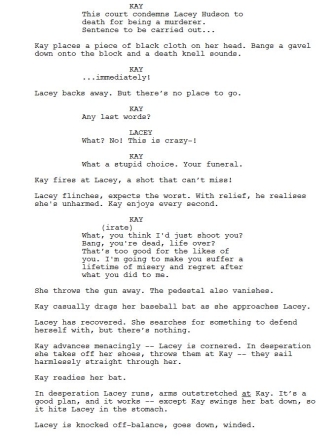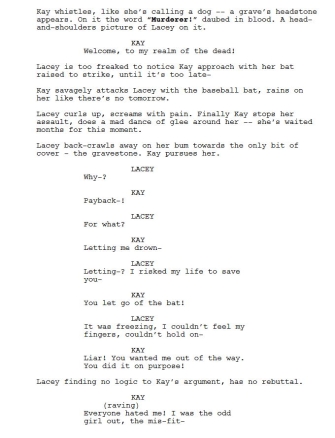Grudge Bearer - Self Tape page
Hi,
Welcome.
Please find details regarding Self Tape submission.
Please submit for either Kay or Lacey, or both if you wish.
Below I have detailed some information on how to submit your self tape, and also some hint and tips.
Good luck 😊
Please find below the tools you will need to submit your Self Tape:
- The two script pages to perform
- The means of submission - via WeTransfer please
- Some Self Tape information; what to include, how to do one, etc
The two pages to perform for your self tape are:
Click on them and they should expand
How to send your Self Tape
Okay, lets talk technical. You have your self tape but how the heck do you upload it. Video files can be tricky to attach to emails – so what do you do?
WeTransfer is industry standard for making Self Tape submissions: www.wetransfer.com
This can be a free service if you only send files every once in a while, to a maximum of 2GB.
To set up a WeTransfer account, simply:
Go to www.wetransfer.com
- Go to Sign Up
- You will need to put in your email, your name (surname is optional).
- WeTransfer will send you an email, confirm it.
- And you’re good to go.
Log into www.wetransfer.com
- An Upload file box will pop up.
- Fill in where you want to send your video to (niftynewtproductions@hotmail.com)
- Enter a brief Subject heading and message
- At the top of the pop-up box is a blue + button – select the video you want to send.
- Once all satisfactory, hit the Transfer
- There will be a progress circle (not shown in the video) that will confirm your video has been sent.
- When Transfer is Complete you can Log out.
Self Tape information to help you:
- The purpose of a Self Tape is to allow the Director to assess how you will interpret the role you are auditioning for; as only so much can be gleaned from a Headshot, Showreel and CV/resume (which is not to say these are not important).
- Note: your Self Tape, like your Headshot, etc, may first be filtered through whoever has Casting responsibilities
- The viewer is assessing your acting/performance, your believability in the role. That doesn’t mean it has to be over-the-top, but convincing - even when you’re not speaking (you are still seen to be the character).
- Each Self Tape is unique to each role. You may update your Headshot and Showreel from time to time but each Self Tape is tailored to the role you’re going for.
- Your performance should be that, a performance - the same as if you were doing it for real on a film set in front of the Director, camera and crew.
- Decide where the other character(s) in the script are around the room, what else is there (whether that be a teapot, campfire or alien spaceship landing) so you can act accordingly.
- You might want to write character names and attach/prop them against something so you don’t forget where they are - don’t make the mistake of having the character jump from one side of the room to another in a couple of seconds – unless your character is The Flash or Superman.
- Remember the camera only sees you, not your “help notes”. The camera doesn’t know (or care) that your notes are propped up against your goldfish’s bowl.
- Decide where the other character(s) in the script are around the room, what else is there (whether that be a teapot, campfire or alien spaceship landing) so you can act accordingly.
- Generally you’ll be sent a couple of pages or so of script for the role you’re auditioning for. Everyone auditioning will get the same material, so the Director can compare.
- Two pages generally equates to two minutes of screen time
- You don’t need a fancy location:
- somewhere quiet
- with a plain background; grey, white or black but make sure you and your clothes show up against it; you don’t want to be “invisible” or a “floating head”
- Could be a wall, a dedicated screen on a stand, or just a sheet suspended behind you.
- And if all else fails (especially before you have a budget for it), just a room as free from clutter as possible, such as a spare room, kitchen or bedroom.
- Try and ensure you give yourself space to act out the scene given.
- No visual or audio distractions – no crazy wallpaper or pets.
- Don’t worry about costume; your everyday clothes will be fine UNLESS you are instructed to wear something specific, in which case follow the instruction to the letter.
- Something neutral or a single solid-colour that can be seen against your background.
- Something that is not the same as your skin colour.
- Form-fitting, so it stays within shot
- Something flattering, that makes you look your best (avoid black, red or white as they don’t show up best on camera)
- Jewellery if you wish, especially if it enhances your performance.
- Piercings, outrageous hair colour, etc might be off-putting to some. If you’re concerned might be detrimental then tone it down or remove them. Individualism is fine but in this instant you are not you, and the more work a Director needs to do to appreciate your performance relative to someone else the harder you’ve made it for yourself.
- Props: if you have something that works then I would advise you use it. Props give the actor something to do with their hands.
- Don’t go crazy, but is you can have something that elevates your performance so it stands out then hopefully it will be remembered.
- A Director/Casting Person may see dozen’s to hundreds of Self Tapes for a role, you want yours to be as memorable as possible.
- If the scene has another character(s) and you have someone willing to voice them then the other character(s) should be off-camera – this is called having a Reader..
- That could be another actor. Find one you trust and “buddy up”; you read for them and they read for you.
- And thanks to today’s technology they need not be in the room – they could do their part over the phone, or video-link. Remember, we just need their audio.
- If you have a Reader to help you then:
- Coach them, so their words have meaning (rather than just read)
- Ensure their voice is picked up by the microphone as evenly as yours. Don’t let their voice over-power yours. It’s your audition.
- The Reader should just read the dialogue (not the Action directions)
- If the Reader is playing different characters, have them use the same voice
- Position them behind the camera, off to one side (but make sure the audio is still fine), or off to one side so you can “play” to them without looking at the camera the same way you would on a set.
- If you don’t have a Reader then you could pre-record the other lines (don’t do both/all in-camera) or be creative; turn it into a monologue – but best if you can to have a Reader.
- That could be another actor. Find one you trust and “buddy up”; you read for them and they read for you.
- Ultimately, the Director need to know that you understand the material and the character (assuming you were given enough information to make that determination)
- Make the quality, both video and audio as good as you can get it. You’re not expected to submit cinematic quality but the visuals and audio should be good:
- Video:
- Ensure there is sufficient lighting on you. A ring-right is great; if not then two light-sources, to light you evenly – but not so much as you appear “flat” on the screen.
- Don’t just have a rear light (window) that puts your face in darkness
- Ensure you’re in focus
- It will likely be watched on a small (phone or tablet) screen – so be mindful of that – don’t crowd the camera. Plus they want to see the whole you, how you inhabit your body, not just your face.
- A medium close-up is the shot best suited for self-tapes.
- Have the camera in “landscape” mode. If you shoot it “Portrait” mode you will be small – they’re unlikely to rotate their screen; even if they can.
- Audio:
- No background distractions (fridge hm, traffic, etc).
- Ensure your voice can be heard clearly
- Your Reader’s voice be equally clear.
- When you can afford it self-tapes on a DSLR camera, tripod, with ring light, independent audio-recorder and grey screen is the way to go – but in the meantime using your smartphone is perfectly fine. (but remember, add lighting!) and on a tripod of course, nothing hand-held.
- Keep the camera still (locked-off). It shouldn’t move at all.
- The shot should be a medium close-up. That is to say from mid-point between your trouser-belt and your chin, and show an inch of gap above the top of your head.
- Have the camera high enough so it’s at your eye-level
- There’s nothing worse than a distorted image, looking up or down.
- Don’t look directly into the camera lens. You wouldn’t normally do it on set, so don’t do it in a self-tape audition
- Don’t slate (clapper board) the audition unless asked to do so.
- If you’re aligning separate audio to video you will need to, but generally if you’re doing that you will probably have rudimentary editing skills so you can exclude it from the finished tape.
- If you hare asked to slate then state the following while you do it: Name, age, role, and any other details they request. Do this as yourself, not in character.
- Ensure the camera is steady. A tripod is best (mini, on a table), but something as simple as propped up against a can of beans is fine. If you’re asking someone to hold the camera then have them rest against a table, wall, etc to steady it as much as possible.
- You are giving a performance, not a table-read. It’s your interpretation of the character in the script that matters.
- However, sometimes if you only get two pages of the script you may not have the luxury of knowing who the character is (that could have been page 1, but you got pages 30 & 32) and rightly or wrongly you will have received no guidance as to what type of person this character is. So glean what you can from the script you have and then make up a backstory; angry, sad, happy, bitter, affable, you get the idea.
- Stick to the script. Otherwise your performance cannot be assessed alongside the others, but also you don’t want to give the impression you might be difficult to work with.
- But sometimes you won’t get time to memorise (or you may be up for multiple roles and it’s too tough to memorise and keep them all straight in your head)
- Thee recipient will appreciate it if you can memorise your lines, but shouldn’t penalise you if you need your notes.
- Try printing out your notes and placing them where your “in performance” eye-line will be on the walls, etc.
- Don’t rush it – prepare! The same way you would for a role.
- But if there’s a deadline, don’t be late submitting.
- Length – generally the script should determine it, but that will also depend on your character (slow and lazy verses hyper). Basically as long as it needs to be.
- That said, if you get instructions about length – follow them!
- If your phone allows you to edit such as iMovie (iPhone) pressing the button at the start/end that’s great, but it shouldn’t be a game-changer to the viewer.
- Or get the Reader to do it – two buttons to press, easy!
- It’s done, time to send it off:
- Check it all the way through before you send it. Then check it again!
- And make sure you’ve followed all the instructions
- Have included all the information they want (name, role, max length, etc)
- Ensure you’re sending a common file type (mp4). You want them to be able to watch it, so if your device records in something obscure you must get it converted.
- Electronic submissions only – unlikely anything else will be asked for.
- Submit early. Some places may watch them as they come in and stop looking if they feel they’ve found who they’re looking for.
- Sadly, these days you may feel like you’re submitting to a void. There’s a worrying trend in business of the “non reply”, where few people bother to acknowledge receipt, let alone give anything back but silence (except for the ones they follow up with). So, aside from a “shame on them” attitude make sure the problem isn’t your end, send your Self Tape to a friend via the same system you would use to submit, to make sure it is actually getting through.
- Video:
Wow, what a long list. But once you’re set up, once you get a few under your belt it will become second nature and you can focus on what matters – your performance.
But above all, don’t be daunted. Remember, you can practice and make as many self tapes as you wish until you get it right – just remember to review so you can send off the best one 😊. (and the right one for that role if you’re auditioning for more than one roll at time)
And if you want to practice on other scripts in the future there’s nothing to stop you downloading a script from the internet (www.simplyscripts.com), picking some pages and having a go.





